
The Walker Art Center is a multidisciplinary contemporary art center in the Lowry Hill neighborhood of Minneapolis, Minnesota, United States. The Walker is one of the most-visited modern and contemporary art museums in the U.S.: together with the adjacent Minneapolis Sculpture Garden and the Cowles Conservatory, it has an annual attendance of around 700,000 visitors. The museum's permanent collection includes over 13,000 modern and contemporary art pieces, including books, costumes, drawings, media works, paintings, photography, prints, and sculpture.

The Hirshhorn Museum and Sculpture Garden is an art museum beside the National Mall in Washington, D.C., United States. The museum was initially endowed during the 1960s with the permanent art collection of Joseph H. Hirshhorn. It was designed by architect Gordon Bunshaft and is part of the Smithsonian Institution. It was conceived as the United States' museum of contemporary and modern art and currently focuses its collection-building and exhibition-planning mainly on the post–World War II period, with particular emphasis on art made during the last 50 years.

The Minneapolis Institute of Art (Mia) is an arts museum located in Minneapolis, Minnesota, United States. Home to more than 90,000 works of art representing 5,000 years of world history, Mia is one of the largest art museums in the United States. Its permanent collection spans about 20,000 years and represents the world's diverse cultures across six continents. The museum has seven curatorial areas: Arts of Africa & the Americas; Contemporary Art; Decorative Arts, Textiles & Sculpture; Asian Art; Paintings; Photography and New Media; and Prints and Drawings.
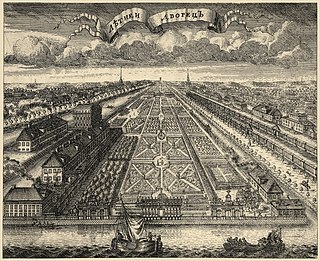
The Summer Garden is a historic public garden that occupies an eponymous island between the Neva, Fontanka, Moika, and the Swan Canal in downtown Saint Petersburg, Russia and shares its name with the adjacent Summer Palace of Peter the Great. Its inception dates back to the early 18th century when Russia took these lands from Sweden in the Great Northern War. Being a monument of landscape architecture featuring original and copied sculptures of classical mythology characters, a former royal palace and a monument to the fable author Ivan Krylov, the garden is now a branch of the Saint Petersburg-based national art treasury Russian Museum.

The Minneapolis Sculpture Garden is an 11-acre (4.5 ha) park in Minneapolis, Minnesota, in the United States. It is located near the Walker Art Center, which operates it in coordination with the Minneapolis Park and Recreation Board. It reopened June 10, 2017, after a reconstruction that resulted with the Walker and Sculpture Garden being unified as one 19-acre campus. It is one of the largest urban sculpture gardens in the country, with 40 permanent art installations and several other temporary pieces that are moved in and out periodically.
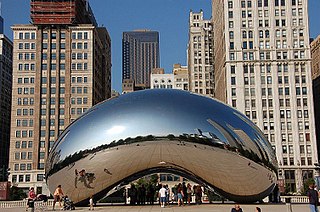
Cloud Gate is a public sculpture by Indian-born British artist Anish Kapoor, that is the centerpiece of AT&T Plaza at Millennium Park in the Loop community area of Chicago, Illinois. The sculpture and AT&T Plaza are located on top of Park Grill, between the Chase Promenade and McCormick Tribune Plaza & Ice Rink. Constructed between 2004 and 2006, the sculpture is nicknamed "The Bean" because of its shape, a name Kapoor initially disliked, but later grew fond of. Kapoor himself even uses this title when referring to his work. Made up of 168 stainless steel plates welded together, its highly polished exterior has no visible seams. It measures 33 by 66 by 42 feet, and weighs 110 short tons.

The Robert Allerton Park is a 1,517-acre (614 ha) park, nature center, and conference center located in the rural Piatt County township of Willow Branch, near Monticello, Illinois, on the upper Sangamon River. The park and manor house, The Farms, are attributed to owner Robert Allerton, industrialist heir, artist, art collector and garden designer. Robert donated the complex to the University of Illinois in 1946.
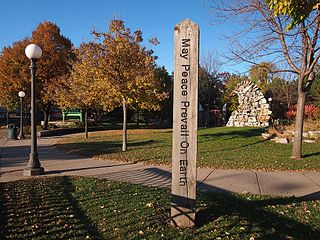
North High Bridge Park is a 0.85-acre (0.34 ha) city park located on the east bank bluffs above the Mississippi River in Saint Paul, Minnesota, United States. The park is adjacent to the High Bridge and was created when the new High Bridge was finished in 1987. The park includes gardens, sculptures and an overlook of the Mississippi River.
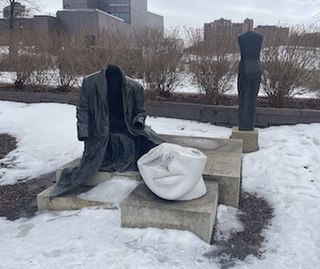
Judith Shea is an American sculptor and artist, born in Philadelphia, Pennsylvania, in 1948. She received a degree in fashion design at Parsons School of Design in 1969 and a BFA in 1975. This dual education formed the basis for her figure based works. Her career has three distinct phases: The use of cloth and clothing forms from 1974 to 1981; Hollow cast metal clothing-figure forms from 1982 until 1991; and carved full-figure statues made of wood, cloth, clay, foam and hair beginning in 1990 to present.
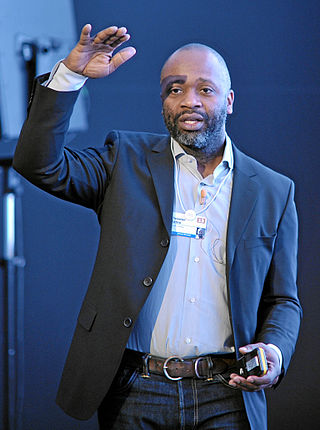
Theaster Gates is an American social practice installation artist and a professor in the Department of Visual Arts at the University of Chicago. He was born in Chicago, Illinois, where he still lives and works.

St. Paul's Church is a Roman Catholic church located at the Veemarkt in Antwerp, Belgium. Its exterior is mainly Gothic with a Baroque tower while the interior is characterised by its rich Baroque decoration. It holds paintings by Antwerp's leading artists Peter Paul Rubens, Anthony van Dyck and Jacob Jordaens as well as abundant sculpture and church furniture crafted by leading Antwerp sculptors such as Artus Quellinus the Elder, Pieter Verbrugghen I, Jan Pieter van Baurscheit de Elder, Jan Claudius de Cock and Andries Colyns de Nole. Of particular note is the Calvary outside the Church which is made up of 63 life-size statues and nine reliefs executed in a popular and theatrical style.

A Grade I-listed statue of Queen Anne stands on a pedestal alongside the north wall of No. 15 Queen Anne's Gate in Westminster, London. It portrays the queen wearing a brocaded skirt and bodice and an open cloak with the insignia of the Order of the Garter; on her head is a small crown and in her hands she holds an orb and sceptre. The statue, carved from Portland stone, stands on a plinth of the same material with the inscription ANNA REGINA. The pedestal consists of a fat "engaged" cylinder with a flat volute on either side, each with scrolls adorned with carved flowers and leaves. Neither the sculptor's identity nor the exact date of the work are known, but it is probably of the early eighteenth century.

Holy Name of Jesus Cathedral is a Catholic cathedral that is the seat of the Diocese of Raleigh, replacing Sacred Heart Cathedral.

Vessel (TKA) is a structure and visitor attraction built as part of the Hudson Yards Redevelopment Project in Manhattan, New York City, New York. The TKA abbreviation in the structure's name stands for "Temporarily Known As". Built to plans by the British designer Thomas Heatherwick, the elaborate honeycomb-like structure rises 16 stories and consists of 154 flights of stairs, 2,500 steps, and 80 landings for visitors to climb. Vessel is the main feature of the 5-acre (2.0 ha) Hudson Yards Public Square. Funded by Hudson Yards developer Related Companies, its final cost is estimated to have been $200 million.
Amanda Williams is a visual artist based in Bridgeport, Chicago. Williams grew up in Chicago's South Side and trained as an architect. Her work investigates color, race, and space while blurring the conventional line between art and architecture. She has taught at the California College of the Arts in San Francisco, Sam Fox School of Design & Visual Arts at Washington University in St. Louis, Illinois Institute of Technology, and her alma mater Cornell University. Williams has lectured at the Metropolitan Museum of Art, New Museum, School of the Art Institute of Chicago, and at a TED conference.

Rebuild Foundation is a non-profit organization dedicated to transforming buildings and neighborhoods in South Side Chicago, sustaining cultural development as well as celebrating art. The Rebuild Foundation was founded in 2009 by Theaster Gates, a social practice installation artist. The Foundation is currently composed of seven projects.

Seitu Jones is a multi-disciplinary artist and community organizer known for his large-scale public artworks and environmental design. Working both independently and in collaboration with other artists, Jones has created over forty large-scale public art works.
Ta-coumba T. Aiken is a painter and public artist who identifies his work as superlative realism. He has created over 600 murals and public art works. A mural Aiken designed in 2013 using over 596,000 Lite Brite pegs holds the Guinness World Record for the largest picture made of Lite Brite. He has also taught and curated. He is sometimes referred to as the "mayor of Lowertown" for his neighborhood presence at his longtime studio in the Lowertown Lofts Artists Cooperative in the Lowertown neighborhood in downtown Saint Paul, Minnesota.
















